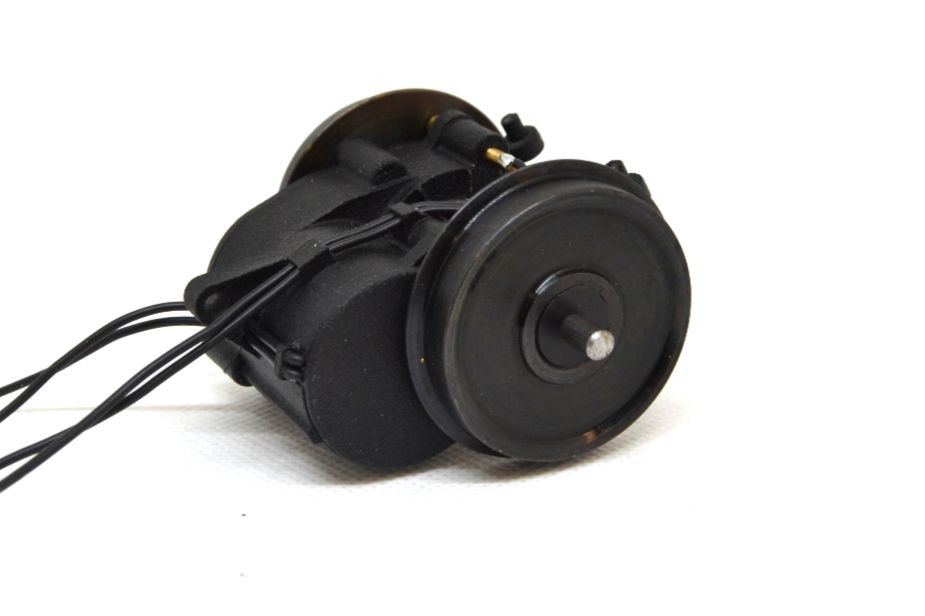One of the biggest dilemmas that we must solve is the motorization. How can we do it? What kind of exist?
Im going to explain the different variables that I’ve been make to get to the conclusion.
Surfing the net-web , I found many possibilities:
- One only motor for all the engages
- One only motor per bogie and siting it above the chassis
- A motor integrated inside the bogie
Uno de los grandes dilemas que hay que resolver antes de nada es el tema de la motorización. Cómo vamos a realizarla? Que variantes existe?
Os voy a explicar las diferentes variantes que he ido realizando hasta llegar a mi conclusión.
Indagando por internet, fueron muchas las variantes encontradas:
- Un solo motor para todo el tren de engranajes.
- Un motor por bogie y colocado por encima del plano del chasis.
- Un motor integrado dentro del bogie.
Once we get all the variants, the one I choose was the motor integrated inside the bogie. I try to find something commercial but everything I found was for G scale, not for 1 scale.
I decided to use the multiples motors from my slot cars and starting to designee the motorization of my 319 locomotive. My target was to include traction to all the shafts, either with a single motor per shaft or one motor for everyone.
The result was not successful at all. We could only use two motor because of the space and the gears where too noisy. An only block enclosed everything and let the bogie very stiff. The running of the bogie was not good enough. The bogie derailed easily.
Visto las diferentes variantes, la que mas me gustó es la del motor integrado dentro del bogie. Busqué algo comercial pero todo lo que encontraba era de la escala G y no de la 1.
Decidí utilizar los múltiples motores que tengo de mis coches de slot y empecé a diseñar mi motorización sobre el bogie de la locomotora 319. Mi premisa siempre fué que todos los ejes tuvieran tracción, ya sea con un motor para todos o con un solo motor por eje.
El resultado no fue del todo satisfactorio. Solo me cabían dos motores y la cadena de engranajes resultaba muy ruidosa. Un bloque encerraba todo con lo que me dejaba el boige muy rígido y el paso por curva no era muy bueno. Descarrilaba con facilidad.
My second prototype, trying to simplified, was to put the motor above the bogie and transmit the traction by a belt. From a central shaft, sharing the traction to all shafts by an endless crown. We improve on noisy side but the transmission ratio was so slow. Didn’t success this system to me. keeping looking for the ideal system.
Mi segundo prototipo por intentar buscar la sencillez, fue colocar el motor fuera del bogie y transmitir a través de una correa dentada, sobre un eje central que repartía la tracción a los tres ejes por medio de unas coronas sin fin. Mejoramos en el tema del ruido pero la relación de trasmisión me parecía excesiva. Lento para mi gusto. Seguía sin convencerme el tener que meter el motor por encima del chasis. Seguía buscando integrar el motor dentro del bogie…
Elements that should get my motorization system:
- Integrated motor inside the bogie
- Single motorized shaft (each one)
- Electrical contact in every single wheel to powering it.
- Suspension
Lateral play on each shaft to improve the curving and don’t derail.
With those targets, first of all I should find the motor. I found a 22mm diameter motor and 24mm length. It was perfect to integrate it between the wheels. For the gearbox I take as a reference the content of creacionesferroviarias. Thanks to Jose Manuel I could found a transmission ratio and integrate all the components. At the end a compact block was born according wit al the targets proposed. All the wiring goes out from inside of the central turning axel of the bogie.
In my section models/miscellaneous you can find an DXF whit the dimensions.
Elementos que debía tener mi motorización.
- Motor integrado en el chasis de bogie
- Motor en cada eje
- Toma de contacto por cada rueda para la alimentación.
- Suspensión.
- Juego lateral independiente por cada eje para mejorar el paso por curva y no descarrilar.
Con estas premisas lo primero que encontré fue un motor de 22mm de diámetro y no mas de 24 mm longitud. Perfecto para integrarlo entre las ruedas. Para la cadena de engranajes, me fijé en la web de creacionesferroviarias. Gracias a Jose Manuel pude dar con una relación de trasmisión y buscar el espacio para aglutinar todos los componentes. Y al final salió un bloque muy compacto que cumplía con todos los requisitos que andaba buscando. Todos los cables salen perfectamente por el interior del eje central de giro del bogie.
En mi sección de Modelos/Varios, podeis encontrar un DXF con las medidas.











